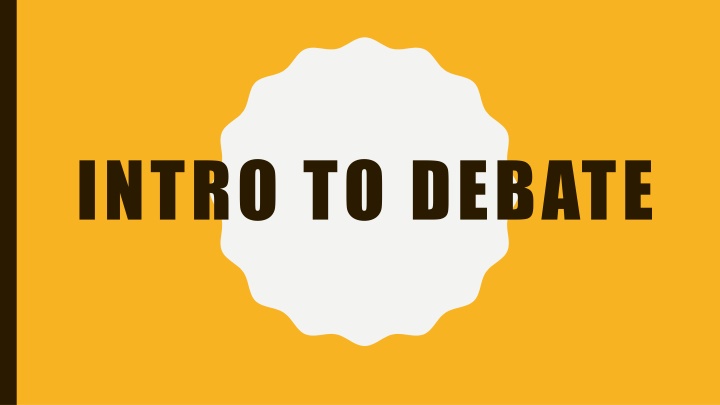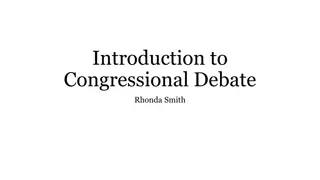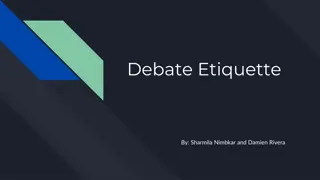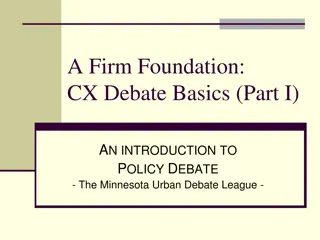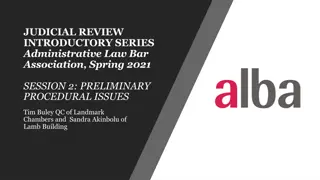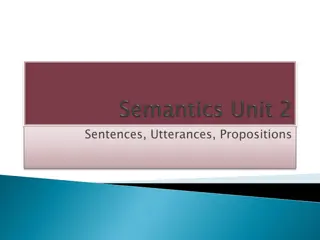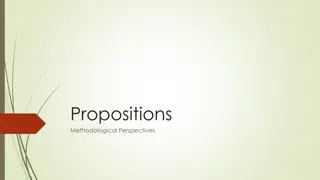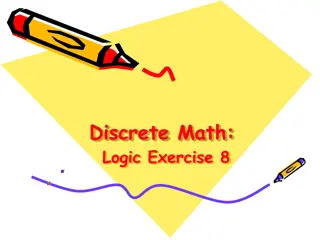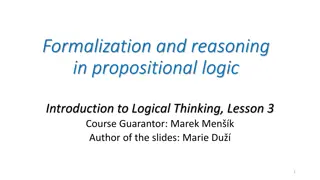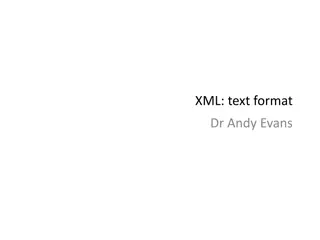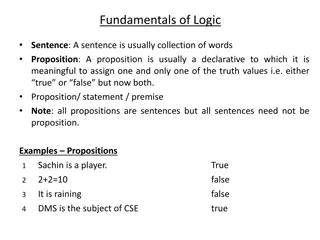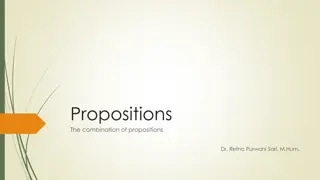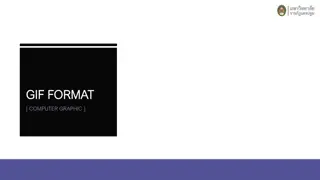An Overview of Debate: Propositions, Teams, and Formats
Debate is a regulated discussion between two matched sides discussing a proposition, with the affirmative arguing for change and the negative defending the status quo. The standard debate format involves constructive arguments followed by rebuttals from both sides. The roles in a debate include the affirmative team, negative team, timekeeper, and judge. The affirmative team presents arguments for adopting the proposition, including justification for change, a plan of action, and its advantages. The negative team responds by refuting the affirmative arguments. Understanding the roles and structure of debate can help participants engage effectively in constructive discussion.
Download Presentation

Please find below an Image/Link to download the presentation.
The content on the website is provided AS IS for your information and personal use only. It may not be sold, licensed, or shared on other websites without obtaining consent from the author.If you encounter any issues during the download, it is possible that the publisher has removed the file from their server.
You are allowed to download the files provided on this website for personal or commercial use, subject to the condition that they are used lawfully. All files are the property of their respective owners.
The content on the website is provided AS IS for your information and personal use only. It may not be sold, licensed, or shared on other websites without obtaining consent from the author.
E N D
Presentation Transcript
WHAT EXACTLY IS DEBATE? A regulated discussion of a proposition by two matched sides
WHAT IS A PROPOSITION? Agreed-upon topic of discussion A statement about which reasonable people may accept arguments on either side
WHAT ARE THE TWO MATCHED SIDES? Affirmative: side that argues that a change should be made in the status quo Status quo: current state of affairs; the laws, regulations, and rules that people live by. Also called the present system. Negative: side that defends the status quo
WHAT IS THE STANDARD DEBATE FORMAT? First Affirmative constructive (8 minutes) First Negative constructive (8 minutes) Second Affirmative constructive (8 minutes) Second Negative constructive (8 minutes) First Negative rebuttal (4 minutes) First Affirmative rebuttal (4 minutes) Second Negative rebuttal (4 minutes) Second Affirmative rebuttal (4 minutes)
WHAT ARE THE ROLES? Affirmative Team Negative Team Timekeeper Judge
AFFIRMATIVE TEAM Argues for the adoption of the debate resolution or proposition Decides which area of the proposition it wishes to discuss, develops a position, and presents an affirmative case
WHAT DOES THE AFFIRMATIVE CASE INCLUDE? 1) Justification for changing the present system 2) A plan of action change 3) The advantages of that plan Often divided into two basic parts: 1) Justification for change (the case side) 2) A plan for implementing change (the plan side)
NEGATIVE TEAM Responds to the affirmative by attacking and destroying the affirmative s arguments. This is called refutation.
HOW DOES THE NEGATIVE REFUTE THE AFFIRMATIVE? 1) Deny the affirmative harm exists Harm: an undesirable effect caused by the present system 2) Claim that adopting the proposition will not solve (or meet) the harm that the affirmative has identified **These kinds of arguments challenge the affirmative s inherency Inherency: issue of whether a problem is caused by the present system, and whether the present system can solve the problem
HOW DOES THE NEGATIVE REFUTE THE AFFIRMATIVE? 3) Attack the affirmative plan. May demonstrate the plan: a) Can be circumvented b) Does not take into account outside factors that could affect the plan c) Has an internal flaw 4) Argue that adopting the affirmative plan will cause negative side effects and that these disadvantages will outweigh any advantages gained by the affirmative plan **To win, the negative needs to win only ONE of these arguments
WHAT DOES A TIMEKEEPER DO? Keeps track of each debater s time Lets the speaker know how much speaking or preparation time has elapsed Counts down time using time cards Counts down in minutes until the last minute when 30 second increments are used
WHAT DOES A JUDGE DO? Evaluates a debate and decides who wins and loses Bases decision on the debaters analysis, reasoning, evidence, organization, refutation, and delivery
WRITING PROPOSITIONS Identify the problem area Problem area: a general issue that causes concern to a community or group of people Narrow down to a specific question
WRITING PROPOSITIONS Example: General Problem area: Should adequate medical care be guaranteed? Specific question: Should medical care for major illnesses be provided for everyone? Proposition: RESOLVED: That the federal government should guarantee medical care for those with catastrophic illnesses.
ELEMENTS OF A STRONG PROPOSITION Significance Controversy Single Idea Debatability Durability
HOW COULD YOU REWRITE THESE FLAWED PROPOSITIONS? a. RESOLVED: That every U.S. citizen should be given an opportunity to earn a living. b. RESOLVED: That strengthening United States alliances with one or more countries in the Middle East would be beneficial. c. RESOLVED: That the U.S. should cut military spending and increase space exploration.
HOW COULD YOU REWRITE THESE FLAWED PROPOSITIONS? d. RESOLVED: That the federal government should establish comprehensive security guidelines for U.S. airports to make them safe. e. RESOLVED: That women should be drafted. f. RESOLVED: That world governments should work to reduce global pollution.
TYPES OF CLAIMS/PROPOSITIONS Proposition of Fact Proposition of Value Proposition of Policy
PROPOSITION OF FACT DEFINITION claim that something verifiable is true (data or facts show that a condition did, does, or will exist) EXAMPLES Detention is ineffective in changing student behavior. Boston will be flooded by the year 2085 if polar ice continues to melt at its current rate.
PROPOSITION OF VALUE DEFINITION claim that something is good or bad, right or wrong, desirable or not involves judgment and often some determination of the criteria of evaluation EXAMPLES Taylor Swift is America's greatest singer. Not paying taxes is immoral.
PROPOSITION OF POLICY DEFINITION claim urges a particular action be taken or a rule/policy/law be adopted to solve a problem EXAMPLES The electoral college system should be abolished. The United States should significantly increase its military presence in the Middle East.
JUSTICE SYSTEM FACT CLAIM The death penalty does not deter crime. VALUE CLAIM Since it is inequitably administered, capital punishment is unjust. POLICY CLAIM Because it does not deter crime, because it is inequitably administered, and because it is unjust, the death penalty should be abandoned by civilized societies.
ENVIRONMENTAL SCIENCE FACT CLAIM The presence and availability of wildlife enriches human life. VALUE CLAIM Changes in land use patterns in Southern California over the past 100 years have rendered the Salton Sea the single most important waterway in the West for migrating waterfowl. POLICY CLAIM Congress must pass effective legislation to ensure the restoration and continued maintenance of the Salton Sea so that loss of avifauna does not diminish human existence.
YOU TRY: PROBLEM AREA: Gun Control TASK In pairs, write a proposition of fact, value, and policy based on the problem area above
YOU TRY: PROBLEM AREA: Education TASK In pairs, write THREE propositions of policy relating to the problem area above.
THE AFFIRMATIVE-TERMS PRESUMPTION: -Assumption that policies in effect should remain in effect; this places the initial burden of proof on the Affirmative BURDEN OF PROOF: -Obligation to provide sufficient reason for adopting a proposition
THE AFFIRMATIVE-RESPONSIBILITIES Because it has the burden of proof (and must overcome presumption), the Affirmative goes first. The Affirmative writes the resolution. The Affirmative gives the first speech-- the First Affirmative Constructive. The Affirmative defines the terms of the resolution
FIRST AFFIRMATIVE CONSTRUCTIVE (1AC) PRIMIA FACIE CASE: The minimal face value argument required to support a resolution The 1AC is the only speech in the debate which can be entirely written out beforehand. If the Affirmative does not make a prima facie case in the 1AC, it typically loses the debate.
FIRST AFFIRMATIVE CONSTRUCTIVE (1AC)-OUTLINE I. Introduces approach II. States Resolution III. Defines Terms IV. States the NEED for Change (Harm, Significance, Inherency) V. Proposes PLAN (shows Solvency) VI. (OPTIONAL) Additional Advantages (if not infringing on 2AC)
DEFINING TERMS OF PROPOSITION Common usage Experts Operational definition (implicit-what it looks like in action) Use of example (analogy/comparison)
STOCK ISSUES HARM: -a problem caused by the presence or absence of current policy SIGNIFICANCE: -deals with the importance or scope of a harm quantitative: numbers, stats -example--many injuries qualitative: violation of important values -example--undermines democracy
STOCK ISSUES INHERENCY -whether a problem is caused by the present system and whether it cannot be solved without the resolution *often shown by gaps or barriers, structural or attitudinal *if Affirmative can't show this, it typically loses because the resolution is not needed
STOCK ISSUES SOLVENCY -will the affirmative plan solve the problem?
STOCK ISSUES Harm, Significance, and Inherency form the CASE Side of the Affirmative speech. These must be argued in order to show the need for the proposed policy.
STOCK ISSUES PLAN -the specific recommended action to support the resolution; made up of plan planks BASIC PLAN PLANKS Mandate: specific reforms to be implemented Administration: who will do it Enforcement: how it will be enforced Funding: how it will be paid for
STOCK ISSUES SOLVENCY -the plan's ability to solve the problem identified in the case; solvency arguments -should correspond to the identified harms -must also show the plan to be workable
TWO PERSON CLASH PREPARATION Break into teams of 2 (middle table will have one group of 3) Decide on a topic and which side will take affirmative/negative (2 minutes) Discuss strategy with your teammate (you may jot down some notes) (5 minutes) DEBATE Affirmative (2 minutes) Negative (2 minutes) Affirmative (1 minute)
STOCK ISSUES The Plan (presented through its planks) and Solvency make up the Affirmative PLAN Side. Beyond Solvency, the Affirmative might also recognize certain Additional Advantages that passing the resolution would bring about. These Additional Advantages are extra benefits; they do not include solving the harmful problems in the case.
NEGATIVE RESPONSIBILITIES The Negative opposes the resolution. The Negative can use multiple strategies to undermine the Affirmative case and plan. STRATEGIES defending the status quo undercutting stock issue claims of Affirmative presenting disadvantages of Aff. plan
NEGATIVE STRATEGIES NEGATIVE PHILOSOPHY The Negative point of view or (overall) position in the debate; this is important to avoid inconsistencies in the Negative attacks
NEGATIVE STRATEGIES NEGATIVE BLOCK The part of a debate when the second Negative constructive speech and first Negative rebuttal speech are delivered back to back; the Negative should use this segment to overwhelm the Affirmative with evidence and refutation
NEGATIVE STRATEGIES MINOR REPAIRS Negative argument that while there is a defect in the present system, it can be fixed with a small change in policy TRENDS ARGUMENT Argument that the present system is already moving toward the desired end, and therefore the Affirmative resolution and plan are unnecessary
NEGATIVE STRATEGIES ATTACK ON HARM OR SIGNIFICANCE challenges the reality or magnitude of the problem presented by the Affirmative ATTACK ON SOLVENCY shows that the Affirmative plan will not solve the harm(s) presented (because it fails to deal with the real cause or because it does not have any demonstrable success elsewhere (analogy))
NEGATIVE STRATEGIES DISADVANTAGE A Harm that the Negative argues will result from adopting the Affirmative resolution or plan ***Negative teams are typically expected to run disadvantage claims!
ARGUING ABOUT THE EVIDENCE COUNTERPOSITION Argument that the real truth is other than what the opposition claims; often involves a presentation of better evidence Also known as Attack on Reliability of Evidence **A good strategy for both sides
NEGATIVE STRATEGIES COUNTERPLAN Strategy in which the Negative concedes the Affirmative harm but proposes a completely different plan of action to deal with the harm This is a risky maneuver, since the Negative gives up all attacks on the case and makes the debate about which plan is more workable and has better solvency evidence
